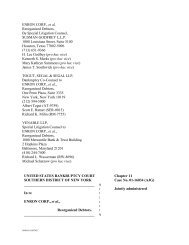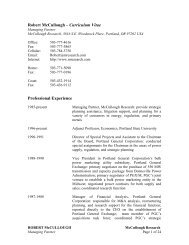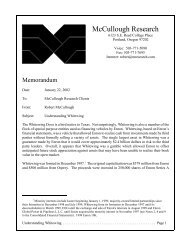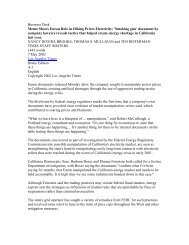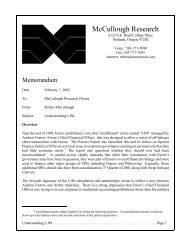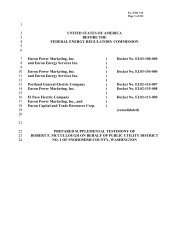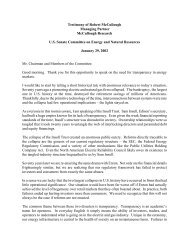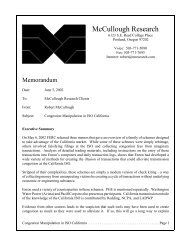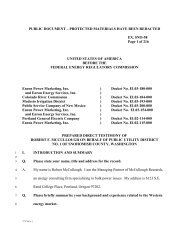I hereby declare that I am Robert McCullough, manager of ...
I hereby declare that I am Robert McCullough, manager of ...
I hereby declare that I am Robert McCullough, manager of ...
You also want an ePaper? Increase the reach of your titles
YUMPU automatically turns print PDFs into web optimized ePapers that Google loves.
UNITED STATES DEPARTMENT OF THE INTERIOR<br />
OFFICE OF HEARINGS AND APPEALS<br />
INTERIOR BOARD OF INDIAN APPEALS<br />
CONFEDERATED TRIBES OF THE )<br />
WARM SPRINGS RESERVATION OF )<br />
OREGON, and ANITA JACKSON, )<br />
CHARLES JACKSON, DEBORAH ) Docket Nos. IBIA 12-142 and<br />
JACKSON, AND MARK JACKSON, ) IBIA 12-143<br />
)<br />
Appellants, )<br />
)<br />
v. ) DECLARATION OF ROBERT<br />
) F. MCCULLOUGH<br />
NORTHWEST REGIONAL )<br />
DIRECTOR, BUREAU OF INDIAN )<br />
AFFAIRS, ) January 25, 2013<br />
Appellee. )<br />
I <strong>hereby</strong> <strong>declare</strong> <strong>that</strong> I <strong>am</strong> <strong>Robert</strong> <strong>McCullough</strong>, <strong>manager</strong> <strong>of</strong> <strong>McCullough</strong> Research, LLC,<br />
an economic consulting firm located in Portland, Oregon. My firm is the economic consultant to<br />
the Jackson appellants in this case and I, personally, <strong>am</strong> the expert who has submitted economic<br />
testimony on their behalf for the past four years. My credentials are filed in BIA No. 1A.<br />
Under full awareness <strong>of</strong> the penalty for perjury, I say as follows:<br />
Executive Summary<br />
1. The answering briefs from the BIA and the Tribe reveal a very poor command <strong>of</strong> the<br />
literature and calculation <strong>of</strong> utility economics. The BIA’s understanding <strong>of</strong> depreciation, for<br />
ex<strong>am</strong>ple, shows a lack <strong>of</strong> understanding <strong>of</strong> FERC record keeping and basic accounting theory.<br />
The complex steps to allow comparison <strong>of</strong> the base load Port Westward plant with the Pelton<br />
Projection also show little understanding <strong>of</strong> electric operations. Overall, the many errors in the<br />
Cardno analysis have understated the estimated impact by $22.3 million dollars.<br />
1<br />
Exhibit A to Jackson<br />
Appellants' Reply Brief<br />
Page 1 <strong>of</strong> 27
Introduction<br />
2. On July 27, 2009, PGE, WSPE (the Warm Springs Power Enterprise), and the<br />
Jacksons met at the WSPE conference room to discuss the appropriate remuneration for the use<br />
<strong>of</strong> the Jackson land under the Reregulation d<strong>am</strong> and reservoir. The meeting was not successful.<br />
PGE proposed, <strong>am</strong>ong other evaluation methods, the use <strong>of</strong> the “power site [net benefits]<br />
formula.” The Jacksons’ representatives counseled the Tribe and PGE <strong>that</strong> the large number <strong>of</strong><br />
assumptions would prove error prone and contentious. The Jacksons recommended a simpler<br />
approach <strong>of</strong> valuing the specific contribution their land made to the Project. 1<br />
A variety <strong>of</strong> materials were presented to BIA staff in the following four years after the<br />
initial meeting. Some <strong>of</strong> these materials are included in the current record, others, apparently<br />
primarily those provided by the Jacksons, have apparently been lost at Cardno or the BIA. 2<br />
In<br />
2009, Jennifer Frozena discouraged submission <strong>of</strong> additional materials since “[they] will simply<br />
delay the process further.” 3<br />
Cardno, as demonstrated in its report, chose to pursue the more complex calculations<br />
recommended by PGE and the Tribe, although no effort over the intervening four years was<br />
made to contact the Jacksons for explanations <strong>of</strong> any issues <strong>that</strong> were not understood in the<br />
materials it had received.<br />
1 The Jackson land is occupied by half the Reregulation D<strong>am</strong> and one third <strong>of</strong> the storage in the Reregulation Pool.<br />
The Reregulation D<strong>am</strong> was built in 1957 to protect the downstre<strong>am</strong> environment from peaking operations at Pelton.<br />
Absent them, Pelton would not be able to increase generation during on-peak hours.<br />
2 The Cardno report references a number <strong>of</strong> places where it could not understand calculations provided by the<br />
Jacksons. The detailed calculations provided to Cardno in November 2008 were apparently not available to the<br />
writer <strong>of</strong> the Cardno report, nor included in the BIA record. The Cardno report only referenced the November 2008<br />
presentation and the September 2009 review <strong>of</strong> the 2009 PGE/Tribal presentation by the Jacksons as attachments.<br />
No reference was made to later documents <strong>that</strong> are in the record such as BIA No. 18 Rebuttal Testimony <strong>of</strong> <strong>Robert</strong><br />
<strong>McCullough</strong>, dated November 18, 2009 with Attachments (BIA No. 18A through BIA No. 18D).<br />
3 Email from Jennifer Frozena [BIA counsel] to John Gould [Jackson counsel], October 1, 2009. PBIA No. 7<br />
2<br />
Exhibit A to Jackson<br />
Appellants' Reply Brief<br />
Page 2 <strong>of</strong> 27
Not surprisingly, the more complex calculations in the Cardno report have proven error<br />
prone and contentious. So much so, it is necessary to provide a careful calculation by calculation<br />
summary to understand where the specific calculations need to be corrected.<br />
The basic structure <strong>of</strong> the Cardno calculation can be confusing. The basic concept is to<br />
compare costs between Pelton and Port Westward, escalate the difference to the present, and then<br />
calculate the present value. And then, finally, use the Jacksons’ share <strong>of</strong> project lands to<br />
calculate the condemnation payment.<br />
This can be summarized in the following formulas:<br />
2012 <br />
where<br />
and<br />
<br />
<br />
<br />
<br />
<br />
<br />
<br />
4 <br />
<br />
<br />
<br />
<br />
<br />
<br />
<br />
<br />
The final step is:<br />
<br />
2012 <br />
<br />
4 “Original cost net <strong>of</strong> accumulated depreciation” is a standard accounting phrase which means the original cost<br />
minus accumulated depreciation from previous time periods.<br />
3<br />
Exhibit A to Jackson<br />
Appellants' Reply Brief<br />
Page 3 <strong>of</strong> 27
3. The first step in the power site formula is to set a date for the comparison and to select<br />
a comparison power project. The logic <strong>of</strong> the power site formula stems from an era before the<br />
development <strong>of</strong> the wholesale power markets in the marketing <strong>of</strong> electricity in the late 1980s.<br />
Before the adoption <strong>of</strong> wholesale market pricing, the only reliable way to estimate value was to<br />
review the costs <strong>of</strong> the most recent comparable plant built by the utility. In 2009 – when PGE<br />
and the Tribe made their presentation – the most recent plant was Port Westward. PGE and the<br />
Tribe proposed the date <strong>of</strong> the comparison as December 31, 2007. 5<br />
Port Westward is not terribly<br />
comparable to Pelton Round Butte, but it was the most recent plant in 2009. 6<br />
Among the adjustments required to make the calculation “apples to apples” is to adjust<br />
the capacity factor – the percentage <strong>of</strong> operations to capacity (more fully explained below) – to<br />
make sure <strong>that</strong> the number <strong>of</strong> kilowatt-hours produced do not prejudice the comparison, by<br />
inflating the denominator <strong>of</strong> the calculation <strong>of</strong> dollars divided by megawatt-hours. This is just<br />
one <strong>of</strong> the areas where corrections to the Cardno report have been recommended by both the<br />
Jacksons and the Tribe. 7<br />
Chart I summarizes the tables in the Cardno analysis and its primary material errors.<br />
Under the Jackson Methodology column, we have shown the significantly less-complex<br />
calculations recommended to value the Jackson Project lands.<br />
///<br />
///<br />
5 BIA No. 69, Attachment 5, page 19.<br />
6 As <strong>of</strong> 2011, the most recent plant is the far more comparable (and more expensive) Biglow project since it is most<br />
recent, renewable, has a low capacity factor, and a similar geographical location.<br />
7 The Tribe has noted <strong>that</strong> the value chosen by Cardno was in error. However, it has recommended comparing the<br />
base load operation <strong>of</strong> Port Westward in 2007 with the peaking operations <strong>of</strong> Pelton, which is also an error.<br />
4<br />
Exhibit A to Jackson<br />
Appellants' Reply Brief<br />
Page 4 <strong>of</strong> 27
Chart I<br />
Steps Cardno Methodology Line Numbers Errors<br />
Jackson Methodology<br />
Table 4‐1 Calculate Port Westward $/MWh 1 1 Capital cost omitted 7 months <strong>of</strong><br />
depreciation<br />
Use market data for energy, capacity, and Renewable Energy<br />
Credits<br />
2 2 Incorrect cost <strong>of</strong> capital<br />
2 3 Home mortgage calculation<br />
3 4 Ommitted depreciation cost<br />
6 5 Incorrect MWh numerator<br />
Table 4‐2 Calculate Pelton and Round Butte 8,9 1 Incorrect capital <strong>am</strong>ount Not needed<br />
$/MWh<br />
11 2 Incorrect cost <strong>of</strong> capital<br />
12 3 Omitted depreciation<br />
8,9 4 Double counted capital and operating<br />
costs<br />
23 5 Omitted Renewable Energy Credits<br />
Table 4‐2 Reregulation Project $/MWh 16 1 Incorrect cost <strong>of</strong> capital Use Tribe's actual interest rate<br />
16 2 Omitted interest<br />
23 3 Omitted Renewable Energy Credits Include Renewable Energy Credits<br />
Table 4‐4 Escalation and Present Valuation 36,37 1 Use <strong>of</strong> the wrong evaluation date Use 2013 since this would be the year <strong>of</strong> the condemnation<br />
36,37 2 Use <strong>of</strong> the wrong Handy Whitman Use the correct Handy Whitman index<br />
Index<br />
39,40 3 Use <strong>of</strong> the incorrect discount rate Use discount rate set out by law for Department <strong>of</strong> Interior<br />
hydro projects<br />
39,40 4 Used the wrong dsicount formula Use the standard financial formula for perpetual assets<br />
Table 4‐5 Adjustment for using the wrong<br />
period in the present value<br />
1 Incorrect financial formula Not Needed<br />
Attachment A 8 to this Declaration consists <strong>of</strong> several tables which discuss the Cardno<br />
calculations on a line by line basis. The calculations on the left were taken from the original<br />
Cardno tables, with their errors displayed in bold and red. The column to the right <strong>of</strong> the Cardno<br />
values notates the corrected calculations in green italics. The column on the far right notes each<br />
error and describes the correction made. Each row can be identified by the row number on the<br />
left <strong>of</strong> the table. Excerpts from Attachment A have been included in the text and references to<br />
Attachment A have been footnoted to make following these computations easier.<br />
Calculation <strong>of</strong> Port Westward’s 2007 Dollars per Megawatt-hour in Table 4-1<br />
4. Cardno’s first determination was to accept the selection <strong>of</strong> Port Westward as the<br />
comparison resource and to calculate a cost per megawatt-hour. This was summarized in Table<br />
4-1 <strong>of</strong> their report.<br />
8 By this reference incorporated herein.<br />
5<br />
Exhibit A to Jackson<br />
Appellants' Reply Brief<br />
Page 5 <strong>of</strong> 27
Cardno made a number <strong>of</strong> errors in Table 4-1. First, Cardno assumed <strong>that</strong> the value taken<br />
from the 2007 FERC Form 1 was net <strong>of</strong> accumulated depreciation. 9<br />
Second, without<br />
documentation or explanation, <strong>that</strong> the cost <strong>of</strong> capital for PGE and Tribes was 9%. 10<br />
Third, it<br />
applied PGE’s assumed cost <strong>of</strong> capital to the original cost as though it were a home mortgage<br />
payment. 11<br />
Fourth, Cardno did not include depreciation as an operating cost. 12 Fifth, it used<br />
seven months <strong>of</strong> baseload generation as a denominator in calculating their dollars per megawatthour.<br />
13 The methodology which should be used in estimating cost <strong>of</strong> generation is based on<br />
generally accepted accounting principles. Any number <strong>of</strong> references are available <strong>that</strong> describe<br />
how to calculate those costs. A standard industry reference is The Regulation <strong>of</strong> Public Utilities<br />
by Charles Phillips. The basic formula for cost is given as:<br />
R = 0 + (V - D)r<br />
where R is the total revenue required,<br />
0 is the operating costs,<br />
V is the gross value <strong>of</strong> the tangible and intangible property,<br />
D is the accrued depreciation <strong>of</strong> the tangible and reproducible property, and<br />
r is the allowed rate <strong>of</strong> return. 14<br />
9 Cardno’s value is located in line one <strong>of</strong> Attachment A.<br />
10 This value, compared to our correction, can be found in line two <strong>of</strong> Attachment A.<br />
11 The conventional home mortgage sets a constant repayment <strong>am</strong>ount over the life <strong>of</strong> the mortgage. Repayment <strong>of</strong><br />
the debt starts at a very low level and increases over the life <strong>of</strong> the mortgage. But this is very rare circumstance in<br />
industry practice. In the case <strong>of</strong> Port Westward, the plant was financed by a portfolio <strong>of</strong> debt and equity. The<br />
repayment <strong>of</strong> debt issues is set out in their <strong>of</strong>fering memoranda and would show no resemblance to a fixed-rate<br />
home mortgage.<br />
12 This error, along with its correction, is notated on line 3 <strong>of</strong> Attachment A.<br />
13 Cardno’s values, along with corrections for Port Westward as on-peak generation are listed in line 6 <strong>of</strong><br />
Attachment A.<br />
14 Phillips, Charles F., THE REGULATION OF PUBLIC UTILITIES: Theory and Practice, (Public Utilities<br />
Reports, 1988), p 169.<br />
6<br />
Exhibit A to Jackson<br />
Appellants' Reply Brief<br />
Page 6 <strong>of</strong> 27
Operating costs includes “all types <strong>of</strong> operating expenses (wages, salaries, fuel,<br />
maintenance, advertising, research, and charitable contributions) plus annual charges for<br />
depreciation and operating taxes.” 15 (Emphasis added.) Depreciation – wear and tear,<br />
colloquially – is a cost <strong>of</strong> operations and a standard part <strong>of</strong> cost determination.<br />
Cardno may have been unaware <strong>that</strong> the FERC Form 1 does not include depreciation in<br />
its Ste<strong>am</strong>-Electric Generating Plant Statistics (Large Plants) data. Instead, depreciation data is<br />
separately shown in the pages entitled “Depreciation and Amortization <strong>of</strong> Electric Plant.”<br />
Similarly, the Director’s lack <strong>of</strong> experience with FERC Form 1’s organization must lead one to<br />
disregard his statement on depreciation, <strong>that</strong> “[g]iven <strong>that</strong> all d<strong>am</strong>s' costs were already<br />
depreciated; there was no need to depreciate them further.” 16<br />
In this case, the “2007 Capital<br />
Cost” for Port Westward neither adjusted for accumulated depreciation, nor included<br />
depreciation as an operating cost, both errors.<br />
In fact, the term “depreciation” represents a cost <strong>of</strong> operation. It reflects a determination<br />
<strong>of</strong> “wear and tear” <strong>of</strong> the equipment over time. The f<strong>am</strong>ily car, for ex<strong>am</strong>ple, “depreciates” over<br />
its expected lifetime from a subject <strong>of</strong> pride to a broken down jalopy. The term “net <strong>of</strong><br />
depreciation” means the capital cost with accumulated depreciation removed. In the case <strong>of</strong> the<br />
f<strong>am</strong>ily car, the value <strong>of</strong> the car is the original cost minus the accumulated wear and tear.<br />
The Director’s Answer continues to note <strong>that</strong> “Cardno requested additional information<br />
directly from the licensees and used this data at face value as provided.” 17<br />
This implies <strong>that</strong><br />
Cardno could not be expected to apply common accounting rules unless it was specifically<br />
15 Id.<br />
16 Director’s Answer, at 20.<br />
17 Id.<br />
7<br />
Exhibit A to Jackson<br />
Appellants' Reply Brief<br />
Page 7 <strong>of</strong> 27
instructed by its data source. A kinder view, favored by the Jacksons, is <strong>that</strong> Cardno simply<br />
forgot to add these costs for Pelton and Port Westward, since they were included in Cardno’s<br />
analysis <strong>of</strong> the Reregulation costs – although in the Reregulation cost analysis Cardno also<br />
forgets to include interest costs. 18<br />
The Tribe’s Answering Brief further muddies the depreciation waters. It says,<br />
“The Tribe understands <strong>that</strong> the nine percent (9%) cost <strong>am</strong>ortization rate used by<br />
Cardno likely includes a component for a return on capital, i.e., depreciation. The<br />
Tribe is not certain because Cardno provides no explanation <strong>of</strong> what is included in<br />
its cost <strong>am</strong>ortization rate.” 19<br />
Although the 9% value is undocumented, the Director’s Answer indicates <strong>that</strong> it was provided by<br />
PGE. 20 This seems reasonable, since the correct value for PGE’s nominal cost <strong>of</strong> capital, 9.03%,<br />
is calculated in the document cited in Patrick Hager’s September 30, 2009 Declaration. 21<br />
But<br />
the source (PGE’s 2009 Integrated Resource Plan) for the correct value (9.03%) makes it clear<br />
<strong>that</strong> the nominal cost <strong>of</strong> capital does not include depreciation:<br />
22<br />
18 Cardno’s reregulation costs and the inclusion <strong>of</strong> interest rates can be found in line seventeen <strong>of</strong> Attachment A.<br />
19 Tribe’s Answering Brief at 29, fn 12.<br />
20 Director’s Answer, at 15.<br />
21 BIA No. 16H.<br />
22 2009 Integrated Resource Plan Addendum, PGE, April 9, 2010, page 12.<br />
8<br />
Exhibit A to Jackson<br />
Appellants' Reply Brief<br />
Page 8 <strong>of</strong> 27
Note <strong>that</strong> this table was used to derive both the nominal cost <strong>of</strong> capital and the after-tax real cost<br />
<strong>of</strong> capital. The nominal value (9.03%) is the actual <strong>am</strong>ount <strong>that</strong> PGE expects to pay its bond<br />
holders and stock holders for capital. This corresponds to the interest rate one’s bank pays on a<br />
deposit. The after-tax real cost <strong>of</strong> capital, 5.59%, is the value <strong>that</strong> reflects the impact <strong>of</strong> taxes<br />
and inflation. Patrick Hager’s 23 declaration recommends <strong>that</strong> this be used as PGE’s discount<br />
rate:<br />
“This real rate <strong>of</strong> return is the s<strong>am</strong>e as the Tribe and PGE have used in their<br />
current net benefits analysis. Such a utility rate <strong>of</strong> return is appropriate here, since<br />
a) it reflects the risks <strong>of</strong> the majority owner <strong>of</strong> the Project (i.e. PGE); b) it reflects<br />
future long-term debt costs <strong>that</strong> PGE will issue, as well as the cost <strong>of</strong> equity; and<br />
c) it reflects PGE's long-term capital structure goal <strong>of</strong> 50 percent equity and 50<br />
percent debt. Further the long-term 5.59% weighted after-tax cost <strong>of</strong> capital is<br />
what is used in PGE's current IRP [Integrated Resource Plan] for long-term<br />
analyses, including net present value calculations.” 24 (Emphasis added.)<br />
Thus, the first correction is to use original cost net accumulated depreciation for the Port<br />
Westward. 25<br />
The second correction to Cardno’s analysis is to use the correct PGE nominal cost<br />
<strong>of</strong> capital instead <strong>of</strong> Cardno’s 9%. 26,27<br />
The third correction is to multiply the cost <strong>of</strong> capital<br />
against original cost net <strong>of</strong> accumulated depreciation. The fourth correction is to include<br />
depreciation on Port Westward as set out in the standard cost formula quoted above. Port<br />
23 PGE’s regulatory affairs <strong>manager</strong> at the time.<br />
24 BIA No. 16H.<br />
25 This value can be found in Attachment A at line one, incorporating seven months <strong>of</strong> depreciation.<br />
26 This allows the analysis to use actual values from original sources – in this case PGE’s Declaration and their<br />
Integrated Resource Plan.<br />
27 The value with this cost <strong>of</strong> capital is located at line two <strong>of</strong> Attachment A. This value includes the 9.03% cost <strong>of</strong><br />
capital over seven months.<br />
9<br />
Exhibit A to Jackson<br />
Appellants' Reply Brief<br />
Page 9 <strong>of</strong> 27
Westward has an expected lifetime <strong>of</strong> 35 years, so straight line depreciation would be 1/35 <strong>of</strong> the<br />
original cost each year. 28<br />
The fifth error concerns the correct number <strong>of</strong> megawatt-hours to use as the denominator<br />
<strong>of</strong> the calculation <strong>of</strong> 2007 dollars per megawatt-hour for both plants, and takes us to the<br />
baseload/peaking load debate. In order to compare Port Westward, a base load unit, to Pelton, a<br />
peaking resource, it is necessary to consider the difference in operations between the two<br />
resources.<br />
To take a simple ex<strong>am</strong>ple, assume <strong>that</strong> you wanted to use this approach to figure out the<br />
rental value <strong>of</strong> a limousine and used the f<strong>am</strong>ily car as a comparison vehicle. The f<strong>am</strong>ily car<br />
drives 10,000 miles a year and costs $30,000. A limousine can drive 50,000 miles a year and<br />
costs $100,000. If you did not correct for the radically different number <strong>of</strong> miles, this approach<br />
would prove <strong>that</strong> limousines are less expensive than f<strong>am</strong>ily cars. Dividing $100,000 by 50,000<br />
miles would indicate a cost <strong>of</strong> $2/mile. The f<strong>am</strong>ily car “cost” would be $30,000 by 10,000 miles<br />
or $3/mile. Without adjusting for the use the vehicle is to be put, you would have to conclude<br />
<strong>that</strong> limousine owners should pay their clients for the use <strong>of</strong> a limousine, rather than vice versa.<br />
To make an apples to apples comparison, you would choose similar mileage for both vehicles in<br />
your analysis. This is the s<strong>am</strong>e point <strong>that</strong> Judge Lande addressed in the 1980 FERC case, 29 as<br />
discussed in our Opening Brief, at 22.<br />
28 This value <strong>of</strong> depreciation can be found in line three <strong>of</strong> Attachment A. We have taken the 2007 Capital Costs and<br />
found the depreciation by year over thirty-five years.<br />
29 BIA No. 14R Initial Decision Adjusting Annual Charges for Use <strong>of</strong> Indian Lands, Allen C. Lande, Presiding<br />
Administrative Law Judge, September 23, 1980, 12 FERC 63.055. at page 16, 6th full paragraph.<br />
10<br />
Exhibit A to Jackson<br />
Appellants' Reply Brief<br />
Page 10 <strong>of</strong> 27
For reasons still unclear, Cardno assumed <strong>that</strong> Pelton /Round Butte was a base load<br />
plant. 30 The fact sheet describing the project on PGE’s web site – created by the licensees –<br />
stresses the peaking nature <strong>of</strong> the plant. 31<br />
The FERC license and the Final Environmental Impact<br />
Study both describe the Pelton Round Butte project as a peaking resource. 32,33<br />
Cardno, in<br />
materials prepared for the Bureau <strong>of</strong> Indian Affairs, described Pelton as a peaking facility in its<br />
comments to FERC in 2003. 34<br />
Dr. McKusick, the author <strong>of</strong> the current Cardno report, stated in<br />
his report to the BIA on the Pelton Project <strong>that</strong>:<br />
30 BIA No. 69 Purchase Price Determination for Certain Indian Land Allotments within the Pelton-Round Butte<br />
Hydroelectric Project Boundary (FERC No. 2030), page 4-2.<br />
31 http://www.portlandgeneral.com/community_environment/initiatives/protecting_fish/deschutes_river/<br />
news_fact_sheets/round_butte_fact_sheet.aspx<br />
32 “The Round Butte and Pelton developments are operated as peaking facilities, typically generating between the<br />
hours <strong>of</strong> 6 a.m. and 11 p.m. daily. Lake Billy Chinook provides seasonal storage and is currently drawn down as<br />
much as 85 feet, to elevation 1,860 feet msl, in the winter, although typically the lake is only drawn down about 10<br />
feet, to elevation 1,935 feet. The lake is typically refilled during the months <strong>of</strong> April and May. During the summer,<br />
the reservoir is held at the highest practicable level with a relatively stable pool elevation <strong>that</strong> usually does not<br />
fluctuate more than 1.0 feet below the normal maximum pool elevation <strong>of</strong> 1,945 feet msl. The surface elevation <strong>of</strong><br />
Lake Simtustus usually fluctuates less than 0.75 feet per day but exceeds 3.5 feet per day about 25 percent <strong>of</strong> the<br />
time due to flow fluctuations produced by Round Butte.” 111 FERC 61,450, “ORDER APPROVING<br />
SETTLEMENT AND ISSUING NEW LICENSE” (June 21, 2005), p. 5.<br />
33 “Typically, PGE dispatches its thermal generating facilities for base-load operations, subject to unit availability<br />
and energy market conditions. PGE's hydroelectric resources, other than the project, are also typically used for baseload<br />
operation, subject to stre<strong>am</strong>flow and reservoir conditions, unit availability, license constraints and regional<br />
coordination <strong>of</strong> hydroelectric operations. These other hydroelectric projects are operated as run-<strong>of</strong>-river projects and<br />
therefore cannot replace the peaking power generated by the Pelton Round Butte Project.<br />
The project is typically operated to provide power during daily load peaks. PGE's other significant load-following<br />
resource, contract power from the mid-Columbia projects, does not have this degree <strong>of</strong> flexibility because <strong>of</strong><br />
environmental and operational constraints. The operational flexibility <strong>of</strong> the project is used by PGE to maintain the<br />
stability and reliability <strong>of</strong> the PGE system.” FINAL ENVIRONMENTAL IMPACT STATEMENT FOR<br />
HYDROPOWER RELICENSING PELTON ROUND BUTTE HYDROELECTRIC PROJECT FERC Project No.<br />
2030-036, (June 2004), p. 3.<br />
34 “While the Round Butte and Pelton developments are store-and-release facilities <strong>that</strong> operate in a load following<br />
or peaking mode, the Reregulating D<strong>am</strong> operates to redistribute upstre<strong>am</strong> peaking flows to provide a relatively<br />
steady downstre<strong>am</strong> flow <strong>of</strong> about the s<strong>am</strong>e magnitude as inflow to Lake Billy Chinook.” PELTON-ROUND<br />
BUTTE HYDROELECTRIC PROJECT LOWER DESCHUTES RIVER INSTREAM FLOW REPORT Prepared<br />
for UNITED STATE DEPARTMENT OF INTERIOR BUREAU OF INDIAN AFFAIRS, Entrix, Inc.. December<br />
2003, page 7.<br />
11<br />
Exhibit A to Jackson<br />
Appellants' Reply Brief<br />
Page 11 <strong>of</strong> 27
“Operation <strong>of</strong> the Project involves the generation <strong>of</strong> electricity in a "peaking<br />
mode" through powerhouses at the Round Butte and Pelton developments.” 35<br />
BIA counsel has invented a new utility resource classification in Regional Director’s Answer<br />
<strong>that</strong> has not otherwise been used in the industry. 36 Further, this new classification contradicts the<br />
Cardno report which states <strong>that</strong> base-load plants operate during 70 to 80 percent <strong>of</strong> the hours in a<br />
year, 37 a magnitude <strong>that</strong> Pelton could not hope to attain in the future nor has ever attained in the<br />
past.<br />
Energy economists and engineers call this concept “capacity factor” – the number <strong>of</strong><br />
megawatt-hours generated during a period (usually a year) divided by the maximum number <strong>of</strong><br />
megawatt-hours the plant could operate. In its first twelve months <strong>of</strong> operation, Port Westward<br />
had a capacity factor <strong>of</strong> 80%. 38<br />
The capacity factor for Pelton, Round Butte, and Reregulation<br />
was 45%. 39 The point is, if an apples to apples analysis is to be conducted between these two<br />
very dissimilar plants in order to compare costs per MWh <strong>of</strong> generation, it would be necessary to<br />
adjust Port Westward’s megawatt-hours for 2007 to reflect its dispatch in 2007 as a peaking<br />
resource.<br />
35 Substantial Evidence in Support <strong>of</strong> Section 4(e) Conditions for the Pelton Round Butte Hydroelectric Project<br />
FERC Project No. 2030, Prepared for Bureau <strong>of</strong> Indian Affairs Portland Area Office, Dr. <strong>Robert</strong> McKusick et al,<br />
November 11, 2002, page 17.<br />
36 “The Pelton Project has characteristics <strong>of</strong> both a base-load and peaking facility. Although the Project does have<br />
peaking capabilities and properties, it is a base-load facility in <strong>that</strong> the three d<strong>am</strong>s <strong>of</strong> the Project work together as<br />
one unit, and the Project in its entirety is not regularly turned "on" or "<strong>of</strong>f' or used only when more power is needed.<br />
Hydropower facilities are generally considered base-load facilities whether they are run-<strong>of</strong>-river or shaped due to<br />
their low fuel costs turned "on" or "<strong>of</strong>f' or used only when more power is needed.” Director’s Answer, at 22.<br />
37 BIA No. 69 Purchase Price Determination for Certain Indian Land Allotments within the Pelton-Round Butte<br />
Hydroelectric Project Boundary (FERC No. 2030), p. 4-2.<br />
38 Megawatt-hours are from the Energy Information Administration at<br />
http://www.eia.gov/electricity/data/eia923/index.html. The capacity value was from the 2007 PGE FERC Form 1,<br />
page 403.<br />
39 Megawatt-hours are from the Energy Information Administration at<br />
http://www.eia.gov/electricity/data/eia923/index.html. The capacity value was from the Final EIS.<br />
12<br />
Exhibit A to Jackson<br />
Appellants' Reply Brief<br />
Page 12 <strong>of</strong> 27
Cardno uses average generation for the hydroelectric facilities in its analysis, but relies on<br />
only seven months <strong>of</strong> Port Westward generation in Table 4-1. The use <strong>of</strong> these seven monthly<br />
values is highly misleading because they reflect base load operation <strong>of</strong> the resource.<br />
The Western Energy Coordinating Council defines peak hours as those after the first six<br />
hours <strong>of</strong> the day and before the last two hours <strong>of</strong> the day from Monday through Saturday. New<br />
Year’s Day, President’s Day, Memorial Day, Independence Day, Labor Day, Thanksgiving, and<br />
Christmas are defined as <strong>of</strong>f-peak days. Since Port Westward’s hourly generation is available<br />
from the Environmental Protection Agency, it is easy to calculate the number <strong>of</strong> megawatt-hours<br />
Port Westward generated on-peak in 2007. 40 In 2007, Port Westward only produced 1,013,787<br />
megawatt-hours on peak. This constituted 58% <strong>of</strong> total generation in 2007. Pelton (comprising<br />
all three d<strong>am</strong>s) produced 72.0% megawatt hours on peak. 41<br />
There is no uncomplicated way to adjust the values in Cardno. The correct approach<br />
would be to use market prices – the revenue approach – which Cardno rejected. In this case, we<br />
have used the average generation from June 2007 through September 2012 (six years <strong>of</strong> data) to<br />
maintain comparability with their similar calculation for the Pelton Project. This adjustment is<br />
made on line 6 <strong>of</strong> Attachment A. 42<br />
The Tribe’s Answering Brief cites two studies to prove <strong>that</strong> Port Westward is a peaking<br />
facility 43<br />
– one describing plants using different technology than used at Port Westward, and a<br />
second, purely theoretical, article deriving the mathematics for a hypothetical plant <strong>that</strong> could<br />
dispatch its component generators independently <strong>of</strong> each other. These are unavailing to remake<br />
40 http://<strong>am</strong>pd.epa.gov/<strong>am</strong>pd/<br />
41 Generation By Development for Pelton Project 2007, 2007 Licensee’s Report to FERC<br />
42 The value in line 6 is the average monthly generation for June 2007 through September 2012 multiplied by seven.<br />
43 Tribe’s Answering Brief, at p. 30, fn. 14.<br />
13<br />
Exhibit A to Jackson<br />
Appellants' Reply Brief<br />
Page 13 <strong>of</strong> 27
the facts. The record is clear: The Oregon Energy Facility Siting Council’s Site Certificate<br />
references Port Westward as a “base load gas plant” throughout its pages and must be treated<br />
accordingly. 44<br />
The following excerpt from Attachment A illustrates the corrections discussed above:<br />
Chart II<br />
Table 4‐1 Benefits per MWh<br />
Line Alternative Project ‐ Port Westward Data Cardno Corrected Values Corrections<br />
1 2007 Capital Costs $267,015,214 $ 262,564,960.43<br />
2 Calculate capital costs at 9.03% $24,358,962 $ 13,830,609.29<br />
3 Straight Line Depreciation (35 Year Life) $ 4,450,253.57<br />
4 2007 Operating & Maintenance Costs $96,634,896 $ 96,634,896.00<br />
5 2007 Total annual project cost (B + C) $120,993,858 $ 114,915,758.86<br />
6 2007 Power Generation (MWh) $1,721,921 $ 1,367,158.41<br />
7 Cost per MWh (D / E) $70 $ 84.05<br />
Error: The original cost should reflect seven months <strong>of</strong> depreciation.<br />
Cardno neglected the first seven months <strong>of</strong> accumulated depreciation in<br />
calculating original cost less accumulated depreciation. We removed<br />
7/12ths <strong>of</strong> one year's depreciation from the original capital less<br />
accumulated depreciation.<br />
Error: Nominal <strong>am</strong>ortization overstates cost <strong>of</strong> capital. We multiplied<br />
capital cost times the assumed cost <strong>of</strong> capital for seven months. Cardno<br />
has proposed using a home mortgage to represent the interest and<br />
<strong>am</strong>ortization for the Port Westward plant PGE finances on a portfolio<br />
basis using 50% debt and equity. The home mortgage approach slightly<br />
overstates the capital costs. The correct capital costs should be<br />
calculated at 9.03% for PGE. The capital cost for 2007 — for seven<br />
months ‐‐ is 9.03% times $262,564,960" or $13,830,609.<br />
Error: A major area <strong>of</strong> cost was omitted from Port Westward. We<br />
calculated straight line depreciation over 35 years. Depreciation is an<br />
operating cost <strong>that</strong> Cardno neglected to include for three <strong>of</strong> the four<br />
plants under analysis here (Cardno did include depreciation as an<br />
operating cost for the Reregulation D<strong>am</strong>). Since Port Westward has a<br />
lifetime <strong>of</strong> 35 years, straight line depreciation would be 1/35th <strong>of</strong> the<br />
original cost per year for seven months.<br />
Error: Assumption <strong>of</strong> base load operation for 7 months. We calculated<br />
Port Westward's on‐peak generation in 2007. Cardno assumed output<br />
at Port Westward based on their erroneous comparative assumption<br />
<strong>that</strong> Pelton Round Butte, too, is a base load generator. Pelton, however,<br />
is a peak load generator. With this information taken into account, Port<br />
Westward on‐peak generation plus the comparable share <strong>of</strong> <strong>of</strong>f‐peak<br />
generation to Pelton's is used as the denominator.<br />
The errors in the Port Westward calculation <strong>of</strong> 2007 cost per megawatt-hour are injurious to the<br />
Jacksons since the numerator was diminished by the omission <strong>of</strong> depreciation and the<br />
denominator assumed base load operation.<br />
Calculation <strong>of</strong> Pelton Cost in 2007 Dollars per Megawatt-hour in Table 4-2<br />
5. Cardno Table 4-2 (Pelton costs) is loosely based on the methodology in Cardno Table<br />
4-1 (Port Westward costs). The errors include using total cost instead <strong>of</strong> cost-net-<strong>of</strong>-<br />
44 SITE CERTIFICATE FOR THE PORT WESTWARD GENERATING PROJECT<br />
ISSUED BY OREGON ENERGY FACILITY SITING COUNCIL (NOVEMBER 8, 2002), pp. 26, 27, and 30,<br />
http://www.oregon.gov/energy/Siting/Pages/PWG.aspx<br />
14<br />
Exhibit A to Jackson<br />
Appellants' Reply Brief<br />
Page 14 <strong>of</strong> 27
depreciation, omitting depreciation costs, double counting capital and operating costs, using the<br />
wrong cost <strong>of</strong> capital, and using a home fixed-rate mortgage calculation instead <strong>of</strong> multiplying<br />
the cost-net-<strong>of</strong>-depreciation times the cost-<strong>of</strong>-capital.<br />
As guidance to third parties for the calculation <strong>of</strong> cost-net-<strong>of</strong>-depreciation at jointlyowned<br />
plants such as Pelton, PGE provides a specific table to describe the original cost and<br />
accumulated depreciation. In 2007, this table was found on page 123.29, Note 10, <strong>of</strong> the PGE<br />
FERC Form 1:<br />
Cost-net-<strong>of</strong>-depreciation should subtract accumulated depreciation. As mentioned above, this<br />
calculation should only have been made once for each plant. In Cardno’s table the capital costs<br />
had been mistakenly multiplied by 1 2 /3. Cardno had misread PGE’s 2007 FERC Form 1 and<br />
included 1 2 /3 the correct costs for Pelton’s capital 45 (before the adjustment required for<br />
accumulated net depreciation). PGE reports two columns in their Form 1 for Pelton and Round<br />
Butte – one at 100% and one at 66.67%. This is explained clearly in the footnotes to the<br />
columns in the Form 1, and in our Opening Brief, at 20.<br />
Referring again to the standard regulatory cost formula from Phillips, the cost <strong>of</strong> capital<br />
should only have been multiplied against cost-net-<strong>of</strong>–accumulated-depreciation -- (V-D)r.<br />
45 Both Pelton and Round Butte values are located in Attachment A at lines nineteen and twenty, respectively.<br />
15<br />
Exhibit A to Jackson<br />
Appellants' Reply Brief<br />
Page 15 <strong>of</strong> 27
Cardno’s approach – a home mortgage paying <strong>of</strong>f the original cost – was error, the harm <strong>of</strong><br />
which is to over-estimate the cost <strong>of</strong> Pelton, to the detriment <strong>of</strong> the Jacksons.<br />
Cardno Table 4-2 includes several additional errors: omitting depreciation, overstating<br />
operating costs by a factor <strong>of</strong> 1 2 /3 due to their misreading for the Form 1, and miscalculating the<br />
cost <strong>of</strong> capital by 1.21%.<br />
As discussed above, it seems likely <strong>that</strong> Cardno’s undocumented cost <strong>of</strong> capital was taken<br />
from PGE’s cost <strong>of</strong> capital calculation in its Integrated Resource Plan. This is a standard<br />
approach for the calculation <strong>of</strong> capital costs. As PGE explained in Note 10, above, “Each joint<br />
owner has provided its own financing.” 46<br />
PGE finances on a corporate basis, blending low risk<br />
investments like Pelton and Round Butte with high risk investments in other areas. The Tribe’s<br />
financing is on a project basis. In 2003, the Tribe issued $50 million in taxable auction rate<br />
securities. 47<br />
At the time <strong>of</strong> issue, the assumed interest rate was approximately 5.40%. 48 The<br />
correct melded cost <strong>of</strong> capital is, therefore, 9.03% for the 2 /3 PGE share, and 5.40% for the 1 /3<br />
Warm Springs share, or 7.82%. 49<br />
Credits for Renewable Operations<br />
6. Cardno also neglected to consider the renewable nature <strong>of</strong> the Pelton/ Round Butte<br />
Project and its redounding benefit to the Jacksons. In 2007, after the Oregon legislature passed<br />
the Renewable Energy Act <strong>of</strong> 2007 (Senate Bill 838), the state <strong>of</strong> Oregon established a<br />
renewable portfolio standard (RPS) for electric utilities and retail electricity suppliers. Different<br />
46 2007 PGE FERC Form 1, page 123.29.<br />
47 FINAL LIMITED OFFERING MEMORANDUM $50,000,000 The Confederated Tribes <strong>of</strong> the Warm Springs<br />
Reservation <strong>of</strong> Oregon Hydroelectric Revenue Bonds, Series 2003 (Pelton-Round Butte Project) (Taxable Auction<br />
Rate Securities), (October 7, 2003)<br />
48 Id., page 20.<br />
49 The correction to the cost <strong>of</strong> capital is on line eleven <strong>of</strong> Attachment A.<br />
16<br />
Exhibit A to Jackson<br />
Appellants' Reply Brief<br />
Page 16 <strong>of</strong> 27
RPS targets apply depending on a utility's size. Electricity service suppliers must meet the<br />
requirements applicable to the electric utilities <strong>that</strong> serve the territories in which the electricity<br />
service supplier sells electricity to retail consumers. Large utilities, like PGE-- those with 3% or<br />
more <strong>of</strong> the state's load -- must ensure <strong>that</strong> a percentage <strong>of</strong> the electricity sold to retail customers<br />
in-state be derived from newer eligible renewable energy resources according to the following<br />
schedule:<br />
5% by 2011<br />
15% by 2015<br />
20% by 2020<br />
25% by 2025<br />
Renewable Energy Credits are provided by a variety <strong>of</strong> resources, including hydro projects built<br />
before 1995. At Pelton/Round Butte, the credits are limited to 50 megawatts. At $3.00 per<br />
megawatt-hour, the revenue impact is 50 times 8,760 hours times $3.00 or $1,314,000. 50<br />
This is<br />
a credit against costs at Pelton /Round Butte and has, accordingly, been netted against (a<br />
reduction in) costs on line 23 on Attachment A.<br />
Calculation <strong>of</strong> Reregulation Cost in 2007 Dollars per Megawatt-hour in Table 4-2<br />
7. Cardno made fewer errors in the analysis <strong>of</strong> the Reregulation D<strong>am</strong> and Reservoir than<br />
it had in the analysis <strong>of</strong> Pelton and Round Butte but added one significant new error. For the<br />
Reregulation D<strong>am</strong>, it correctly added depreciation to the costs, but then omitted interest costs.<br />
This was apparently due to the omission <strong>of</strong> interest costs from the Tribe’s response to Cardno’s<br />
50 2007 PGE renewable tariff at http://edocs.puc.state.or.us/efdocs/UAA/3134uaa12351.pdf<br />
17<br />
Exhibit A to Jackson<br />
Appellants' Reply Brief<br />
Page 17 <strong>of</strong> 27
equest for capital costs. 51<br />
Cardno had asked for a full set <strong>of</strong> costs, but seemingly did not notice<br />
any omissions in the Tribe’s response. 52<br />
The Tribe listed the original value <strong>of</strong> the reregulation d<strong>am</strong> and powerhouse as<br />
$31,796,575 in their 1990 FERC Form 1. 53 Assuming 25 years <strong>of</strong> straight line depreciation from<br />
1982 through 2007, the original cost net <strong>of</strong> depreciation would be 25/50ths <strong>of</strong> the original cost,<br />
or $15,898,287. The financing cost for the 2003 bonds was 5.40%, so the cost <strong>of</strong> capital is<br />
$858,508. 54 This is corrected on line 16 <strong>of</strong> Attachment A.<br />
The following excerpt from Attachment A summarizes the corrections to Table 4-2.<br />
///<br />
///<br />
///<br />
///<br />
///<br />
///<br />
///<br />
51 BIA No. 69 Re: Confidential Information: Costs and Alternative Power Costs <strong>of</strong> Reregulating D<strong>am</strong><br />
and Powerhouse, November 29, 2011.<br />
52 “1. Itemized actual annual costs <strong>of</strong> the Reregulating portion <strong>of</strong> the Project, including all operating & maintenance<br />
costs and all capital costs (including capital additions and capital carrying costs, broken out as appropriate), for the<br />
most recent 10 years available;” BIA No. 47.<br />
53 1990 Warm Springs Power Enterprises FERC Form 1, page 406, line 19.<br />
54 FINAL LIMITED OFFERING MEMORANDUM $50,000,000 The Confederated Tribes <strong>of</strong> the Warm Springs<br />
Reservation <strong>of</strong> Oregon Hydroelectric Revenue Bonds, Series 2003 (Pelton-Round Butte Project) (Taxable Auction<br />
Rate Securities) ( October 7, 2003), p. 20.<br />
18<br />
Exhibit A to Jackson<br />
Appellants' Reply Brief<br />
Page 18 <strong>of</strong> 27
Chart III<br />
Table 4‐2 Net Benefits per MWh<br />
Line Pelton Round Butte Project Costs Cardno Corrected Values Corrections<br />
Error: Capital costs have been double counted. In PGE's 2007 FERC Form<br />
8 2007 Pelton Capital Costs $57,160,309<br />
1, there are two columns dedicated to capital costs. One <strong>of</strong> these<br />
$20,991,211<br />
represents the total value, while the other presents two thirds <strong>of</strong> total<br />
value to represent PGE's ownership <strong>of</strong> the d<strong>am</strong>. Cardno incorrectly<br />
summed these values, and then failed to net accumulated depreciation.<br />
9 2007 Round Butte Capital Costs $121,310,087 $44,549,193 We used the correct 2007 values from PGE FERC Form 1.<br />
10 2007 Total Pelton Round Butte Capital Costs (A + B) $178,470,396 $65,540,404<br />
11 Correct Cost <strong>of</strong> Capital<br />
Error: Capital Costs are overstated. PGE financed 66.67% <strong>of</strong> the project<br />
at its cost <strong>of</strong> capital <strong>of</strong> 9.03% while the Tribe financed at a rate <strong>of</strong> 5.4%.<br />
Taking the weighted average these two values yields an average cost <strong>of</strong><br />
7.82% capital <strong>of</strong> 7.82%.<br />
12<br />
Original Cost Net Accumulated Depreciation Times Cost<br />
<strong>of</strong> Capital $16,281,295 $5,125,260<br />
Error: Nominal <strong>am</strong>ortization overstates the cost <strong>of</strong> capital. Cardno<br />
applied a formula for a home mortgage instead <strong>of</strong> multiplying the<br />
original cost net accumulated depreciation times the melded cost <strong>of</strong><br />
capital.<br />
13 2007 Pelton Straight Line Depreciation (50 Year Life) $685,910 Error: (lines 13 and 14): Missing depreciation for Pelton Round Butte.<br />
14 2007 Round Butte Straight Line Depreciation (50 Year Life) $1,455,692 Straight line depreciation assuming a fifty year life<br />
15 Depreciation from Warm Springs data $627,868 Depreciation from Warm Springs data.<br />
16 Tribe's Cost <strong>of</strong> Capital at 5.4% $858,508<br />
ERROR: Depreciation only ‐ no cost <strong>of</strong> capital. This value is the product<br />
<strong>of</strong> the Tribal cost <strong>of</strong> capital, 5.40%, and the undepreciated balance <strong>of</strong><br />
the Reregulation D<strong>am</strong> taken from 1990 WSPE FERC Form 1.<br />
17 2007 Annual Re‐Reg Capital Costs $627,868 $1,486,376<br />
18 Total Annual Project Capital Costs (D + E) $16,909,163 $8,753,237<br />
19 2007 Pelton Operating & Maintenance Costs $2,596,538 $1,811,108 Error (lines 19 and 20): Pelton Operating and Maintenance costs were<br />
20 2007 Round Butte Operating & Maintenance Costs $6,999,414 $3,919,303 double counted. Correct 2007 values from PGE FERC Form 1.<br />
21 2007 Re‐Reg Operating & Maintenance Costs $1,137,183 $1,137,183<br />
22 2007 Project Operating & Maintenance Costs (G + H + I) $10,733,135 $6,867,594<br />
23 Credit for Renewable Energy Certificates<br />
Error: Missing Value <strong>of</strong> REC credits. The product <strong>of</strong> these = 50<br />
megawatts, 8760 hours in a year, and $3 per megawatt‐hour from<br />
$1,314,000 PGE's contemporaneous tariff.<br />
24 2007 Total annual project cost (F + J) $27,642,298 $14,306,831<br />
25 2007 Power Generation (MWh) $1,464,949 $1,464,949<br />
26 Cost per MWh (2007 $/MWh) (K / L) $18.87 $9.77<br />
27 Net Benefit per MWh (Table 4‐1 F – Table 4‐2 M) $51.40 $74.29<br />
The calculation <strong>of</strong> Pelton Project costs disadvantaged the Jacksons since depreciation was<br />
omitted on both the Pelton D<strong>am</strong> and the Round Butte d<strong>am</strong>. Depreciation was included for the<br />
Reregulation d<strong>am</strong>, but in this case Cardno neglected to include interest. The calculation also<br />
neglected to use the tribal cost <strong>of</strong> capital for Tribal assets. The sum <strong>of</strong> these and other errors was<br />
to overstate significantly the average cost per megawatt-hour in 2007.<br />
///<br />
///<br />
///<br />
19<br />
Exhibit A to Jackson<br />
Appellants' Reply Brief<br />
Page 19 <strong>of</strong> 27
Use <strong>of</strong> the Handy Whitman Index in Table 4-4<br />
8. Cardno does not explain the use <strong>of</strong> the wrong Handy Whitman index for the wrong<br />
plant type at the wrong location for the wrong year. The Director <strong>of</strong>fers <strong>that</strong><br />
“In order to limit the number <strong>of</strong> unspecified variables and to improve<br />
transparency, Cardno used data and information provided by the licensees and<br />
publicly available information to assess each <strong>of</strong> the calculations provided.<br />
Unfortunately, neither the Jacksons nor the licensees provided a complete or<br />
excerpted Handy-Whitman Index for Cardno's use during this effort even though<br />
both were asked to provide all information necessary to derive a fair market value.<br />
Contrary to the Jacksons' assertions, the Handy-Whitman Index is not readily or<br />
publicly available. A prospective user must purchase the right to use the Index,<br />
and the cost is quite significant.” 57<br />
It must be noted <strong>that</strong> neither the BIA nor Cardno contacted the Jacksons on this issue – or, in<br />
fact, on any factual issue after September, 2009. The correct Handy Whitman index is available<br />
next door to the BIA <strong>of</strong>fices at the Bonneville Power Administration library. The access number<br />
is 1092-955x. There is no charge for its use. The purchase cost <strong>of</strong> the Handy Whitman index is<br />
$175 and can be purchased like any other reference material – over the phone or the internet.<br />
Since Port Westward is a gas fueled turbogenerator in Oregon, Pelton/Round Butte are<br />
hydroelectric d<strong>am</strong>s in Oregon, it is inappropriate to use the Handy Whitman index for a ste<strong>am</strong><br />
unit in New England.<br />
The Director continues:<br />
“The BIA maintains <strong>that</strong> escalation to 2011 was appropriate. Cardno's analysis<br />
was completed in late 2011, and the Regional Director's decision was issued<br />
approximately seven months later. It was not necessary to re-index the purchase<br />
price to account for the time period between December 2011 and July 2012.” 58<br />
55 We have corrected this error by multiplying the cost <strong>of</strong> depreciation in line ten by the cost <strong>of</strong> capital in line eleven.<br />
56 Each <strong>of</strong> these values takes the Pelton capital costs in line eight and the Round Butte capital costs in line nine and<br />
multiplies them by two percent.<br />
57 Director’s Answer, at 23.<br />
58 Id., at 25.<br />
20<br />
Exhibit A to Jackson<br />
Appellants' Reply Brief<br />
Page 20 <strong>of</strong> 27
The Cardno report was delivered to the BIA on April 17, 2012 and Mr. Dach summarized the<br />
report in a memo on May 30, 2012. 59,60<br />
Under no circumstance would it have been reasonable<br />
to assume the condemnation could have taken place in the year preceding the completion <strong>of</strong> the<br />
report since the condemnation could only take place after the valuation was complete. The<br />
Handy Whitman corrections are on lines 36 through 40 <strong>of</strong> Attachment A.<br />
Calculation <strong>of</strong> Present Value in Table 4-4<br />
9. The selection <strong>of</strong> a discount rate is an important – perhaps the most important – part <strong>of</strong><br />
an economic analysis, especially so in the reduction <strong>of</strong> a column <strong>of</strong> income to its present value.<br />
In the case <strong>of</strong> the Director’s Decision, every mention <strong>of</strong> the discount rate to be used in the<br />
Cardno study indicates <strong>that</strong> the correct real rate is 3.00%. 61,62,63<br />
There is no support in the record<br />
for the use <strong>of</strong> 9.00%. Nine percent is even more inexplicable when the record contains a<br />
declaration by PGE rejecting this value in favor <strong>of</strong> the use <strong>of</strong> PGE’s real discount rate, 5.59%. 64<br />
Even the Tribe mentions correcting this error, but goes on to argue <strong>that</strong> unspecified risks should<br />
then be used to increase the value. 65<br />
This argument is new to the Tribe and specifically<br />
contradicts its previously held position in this record. In September, 2009, it wrote to BIA,<br />
59 BIA No. 69 Memorandum from Bob Dach to Greg Argel, dated May 30, 2012, RE: Transmittal <strong>of</strong> Purchase Price<br />
Determination for Certain Indian Land Allotments within the Pelton-Round Butte Hydroelectric Project Boundary<br />
(FERC No. 2030) prepared by Cardno ENTRIX, dated April 2012 (Attachment)<br />
60 BIA No. 69 Purchase Price Recommendation for Certain Indian Land Allotments within the Pelton<br />
- Round Butte Hydroelectric Project Boundary.<br />
61 BIA No. 70 Re: Tribal request to purchase interests in Allotments 528, 532, and 292, page 6.<br />
62 BIA No. 69 Purchase Price Recommendation for Certain Indian Land Allotments within the Pelton<br />
- Round Butte Hydroelectric Project Boundary, May 30, 2012, pages 3 and 6.<br />
63 BIA No. 21 RE Response to Request for Information dated March 9, 2010.<br />
64 BIA No. 16H Declaration <strong>of</strong> Patrick Hager, September 30, 2009.<br />
65 Tribe’s Answering Brief, at 22.<br />
21<br />
Exhibit A to Jackson<br />
Appellants' Reply Brief<br />
Page 21 <strong>of</strong> 27
“The Tribe and PGE have revised the capitalization factor used in the GSA<br />
income approach to convert the annual revenues to a purchase price. The new<br />
capitalization factor is 17.89, reflecting a real weighted after-tax cost <strong>of</strong> capital (or<br />
rate <strong>of</strong> return) <strong>of</strong> 5.59 percent (1 divided by .0559). This real rate <strong>of</strong> return is the<br />
s<strong>am</strong>e as the Tribe and PGE have used in their current net benefits analysis. ***<br />
Such a utility rate <strong>of</strong> return is what FERC used in determining annual charges in<br />
the PGE case, see 12 FERC 63055, WL at 14, and is appropriate here since it<br />
reflects: a) the risks <strong>of</strong> the majority owner <strong>of</strong> the Project (i.e., PGE); and b) future<br />
long-term debt costs <strong>that</strong> PGE will issue, as well as the cost <strong>of</strong> equity; and c)<br />
reflects PGE's long-term capital structure goal <strong>of</strong> 50 percent equity and 50 percent<br />
debt.” 66 (Emphasis added.)<br />
At the heart <strong>of</strong> the problem is a fund<strong>am</strong>ental misunderstanding <strong>of</strong> the use <strong>of</strong> a discount rate. The<br />
Bureau <strong>of</strong> Indian Affairs’ role in this proceeding was to set a price for the taking <strong>of</strong> a specific<br />
property owned by the Jacksons. To do this, the Director found a rental rate in dollars per<br />
megawatt-hour and then applied it to the share <strong>of</strong> Pelton Round Butte owned by the Jacksons.<br />
To reimburse the Jacksons for the loss <strong>of</strong> this stre<strong>am</strong> <strong>of</strong> income, the Jacksons need to<br />
receive a lump sum payment, prudently invested, <strong>that</strong> would provide a comparable income<br />
stre<strong>am</strong>. The Cardno report has not done this: First, Cardno has ignored the Jacksons (and their<br />
appropriate discount rate) as the recipient <strong>of</strong> the lump sum sought to be calculated. Second,<br />
having selected PGE, not the Jacksons, as the apparently appropriate focus, Cardno has<br />
disregarded PGE’s pr<strong>of</strong>fered testimony on the subject, as shown above. Third, even assuming<br />
utility focus is warranted (which it is not), Cardno has ignored the tabulated results <strong>of</strong> a<br />
contemporaneous survey on the very subject <strong>of</strong> the inquiry, conducted by the Northwest<br />
Regional Power Council, and included in the record:<br />
66 BIA No. 16, Letter from Ellen Grover to Stanley Speaks, dated September 30. 2009 RE ILCA Proceeding in<br />
Purchase <strong>of</strong> Allotments 292, 528 and 532 with Attachments, p. 13.<br />
22<br />
Exhibit A to Jackson<br />
Appellants' Reply Brief<br />
Page 22 <strong>of</strong> 27
67<br />
In short, the Cardno report has used a real discount rate higher than discount rate used by any<br />
utility in the Pacific Northwest – or any other alternative -- as if the Jacksons could expect this<br />
rate <strong>of</strong> return in today’s markets. A real discount rate <strong>of</strong> 9% would certainly does not reflect a<br />
prudent investment open to the Jacksons in 2013.<br />
The Bureau <strong>of</strong> Indian Affairs filed a declaration in this case in October demonstrating<br />
<strong>that</strong> interest rates – nominal, before the adjustment for inflation – were 3.64% for individual<br />
Indians with money deposited (in IMMs) with the Federal Trustee. 68<br />
Adjusted for inflation, this<br />
would indicate a real discount rate below 2.00% -- lower than the discount rate adopted in the<br />
Decision. 69<br />
Tribal counsel has repeatedly averred, without evidence, <strong>that</strong> a 3.00% real discount rate is<br />
“risk-free.” 70 This assertion is factually incorrect. It is generally accepted <strong>that</strong> the risk-free rate<br />
is best approximated by securities <strong>of</strong> the United States federal government. Use <strong>of</strong> these rates<br />
for economic analysis is set out in Circular A-94 Appendix C, updated annually by the Office <strong>of</strong><br />
67 BIA No.1G, Sixth Northwest Conservation and Electric Power Plan, Northwest Power and Conservation Council,<br />
February 2010, page N-8.<br />
68 Declaration <strong>of</strong> Catherine Rugen re bond <strong>am</strong>ount, October 10, 2012, page 1.<br />
69 At page 6.<br />
70 Tribe’s Answering Brief, at 22, for ex<strong>am</strong>ple.<br />
23<br />
Exhibit A to Jackson<br />
Appellants' Reply Brief<br />
Page 23 <strong>of</strong> 27
Management and Budget and published on the White House web site. The most recent risk-free<br />
rates are:<br />
71<br />
BIA counsel has opined “The reasonableness <strong>of</strong> this number [<strong>of</strong> 9% for PGE’s discount rate] is<br />
reinforced by FERC itself - in its economic analyses FERC typically assumes a discount rate <strong>of</strong><br />
10% during relicensing. See, e.g., <strong>Robert</strong> Black, Bruce McKenney and <strong>Robert</strong> Unsworth, U.S.<br />
Fish and Wildlife Service, Economic Analysis for Hydropower Project Relicensing: Guidance<br />
and Alternative Methods.” 72<br />
This fifteen year old document, circa 1998, is incorrect. FERC<br />
does not use 10% for all reviews, nor did it do so in its review <strong>of</strong> the Pelton Round Butte project<br />
for relicensing in 2004. 73<br />
The Director confides <strong>that</strong>, “Cardno was not aware <strong>of</strong> any case <strong>that</strong> used a rate as low as<br />
5.59 percent, and indeed, a 5.59 percent rate was not used by the licensees in their net benefits<br />
calculations ***,” 74 but this is wrong. <strong>Robert</strong> McKusick, the author <strong>of</strong> the Cardno report, was<br />
also one <strong>of</strong> the authors <strong>of</strong> a recent environmental analysis, dated August 11, 2010, <strong>that</strong> used<br />
71 http://www.whitehouse.gov/omb/circulars_a094/a94_appx-c<br />
72 Regional Director’s Answer, December 21, 2012, page 16.<br />
73 FINAL ENVIRONMENTAL IMPACT STATEMENT FOR HYDROPOWER RELICENSING PELTON<br />
ROUND BUTTE HYDROELECTRIC PROJECT FERC Project No. 2030-036, (June 2004), p. 271.<br />
74 Director’s Answer, at 16.<br />
24<br />
Exhibit A to Jackson<br />
Appellants' Reply Brief<br />
Page 24 <strong>of</strong> 27
3.00%, 75 and PGE and the Tribe did use the 5.59%, as they said explicitly in a September 2009<br />
letter to the Director:<br />
“The Tribe and PGE have revised the capitalization factor used in the GSA<br />
income approach to convert the annual revenues to the purchase price. The new<br />
capitalization factor is 17.89, reflecting a real weighted after-tax cost <strong>of</strong> capital (or<br />
rate <strong>of</strong> return) <strong>of</strong> 5.59 percent (1 divided by .0559). This real rate <strong>of</strong> return is the<br />
s<strong>am</strong>e as the Tribe and PGE have used in their current net benefits analysis. ***<br />
Further, the long-term 5.59 percent weighted after-tax cost <strong>of</strong> capital is what is<br />
used in PGE's current Integrated Resources Plan for long-term analyses, including<br />
net present value calculations. 76 (Emphasis added.)<br />
Finally, the Director avers, without justification, <strong>that</strong> the Jacksons support use <strong>of</strong> PGE’s discount<br />
rate in the present value <strong>of</strong> rent to be paid to the Jacksons. 77<br />
This is simply incorrect. The<br />
Jacksons’ position is the s<strong>am</strong>e as the Director’s, “<strong>that</strong> a 3 percent discount rate is most<br />
appropriate.” 78<br />
The following excerpt is from Attachment A.<br />
///<br />
///<br />
///<br />
///<br />
///<br />
75 Final Regulatory Impact Statement (RIR) /4(b)(2), Preparatory Assessment/FRFA for the Critical Habitat<br />
Designation <strong>of</strong> Cook Inlet Beluga Whale, Michael Nagy, <strong>Robert</strong> McKusick, Krieg Brown, and Rabia Ahmed,<br />
August 11, 2010, pp. 7-12, 9-4, and 9-5.<br />
http://www.fakr.noaa.gov/protectedresources/whales/beluga/chabitat/cib_economicanalysis0810.pdf<br />
76 BIA No. 16, Letter from Ellen Grover to Stanley Speaks, dated September 30, 2009, RE ILCA Proceeding in<br />
Purchase <strong>of</strong> Allotments 292, 528 and 532 with Attachments, p. 13.<br />
77 Director’s Answer, at 14.<br />
78 Id., at 41.<br />
25<br />
Exhibit A to Jackson<br />
Appellants' Reply Brief<br />
Page 25 <strong>of</strong> 27
Chart IV<br />
Table 4‐4<br />
Line Calculation <strong>of</strong> Net Benefits Cardno Corrected Values Corrections<br />
28 Net Benefit per MWh (2007 $/MWh) (Table 4‐2, N) $51.00 $<br />
74.29<br />
29 Average annual power generation (MWh) (Table 4‐3) 1,447,986 1,447,986<br />
30 Port Westward Value $ 121,709,678.44 Cost per MWh taken from Table 4‐1 (Corrected)<br />
31 Pelton Round Butte Value $ 14,141,168.74 Cost per MWh taken from Table 4‐2 (Corrected)<br />
32 Total Annual Net Benefits (2007 $) (A * B) $74,423,119.00 $ 107,568,509.71<br />
33 Port Westward Value (Present Value at 3%) $ 4,056,989,281.43<br />
34 Pelton Round Butte Value (Present Value at 3%) $ 471,372,291.23<br />
35<br />
Total Project Net Benefits (Present value C over 50 years<br />
with 9% rate) $815,802,633.00 $<br />
Cardno used the wrong formula (present value at 50 years) and the<br />
3,585,616,990.19<br />
wrong discount rate (9%)<br />
36 Handy‐Whitman Index (Pacific Turbo Generator to 2012)<br />
Error: Wrong Handy Whitman index used in line 38. We used the<br />
appropriate Handy‐Whitman index for a turbogenerator on the Pacific<br />
1.49 coast calculated from 2007 to 2012.<br />
37 Handy‐Whitman Index (Pacific Hydro Generator to 2012)<br />
Error: Wrong Handy Whitman index used in line 38. We used the<br />
appropriate Handy‐Whitman index for a hydroelectric plant on the<br />
1.13 Pacific coast calculated from 2007 through 2012.<br />
38 Handy‐Whitman Index (convert 2007 dollars to 2011 dollar 1.15<br />
Error: Wrong Handy Whitman Index for the wrong plant at the wrong<br />
location for the wrong plant type and the wrong year.<br />
39<br />
Port Westward Value (Present Value at 3%) Indexed to<br />
2012 (million $) $ 6,034.48 Indexed to 2012<br />
40<br />
Pelton Round Butte Value (Present Value at 3%) Indexed<br />
to 2012 (million $) $ 530.29 Indexed to 2012<br />
2012 Total Project Net Benefits (Difference between Port<br />
41 Westward and Pelton Round Butte) (million $) $ 936.54 $ 5,504.18 Calculated Difference.<br />
The choice <strong>of</strong> the 9% undocumented and erroneous discount rate is deeply disadvantageous to<br />
the Jacksons. The Jacksons are assumed to be able to invest their dollars at a rate much higher<br />
than the evidence filed by the BIA for an individual Indian’s investments. Adding to the bias<br />
against the Jacksons is the use <strong>of</strong> the wrong handy Whitman index for the wrong location, the<br />
wrong technology, and the wrong time period.<br />
Calculated using rate from Regional Director Speaks decision by using<br />
the rate <strong>of</strong> 3% and applying the standard financial calculation for<br />
investment stre<strong>am</strong>s without a maturation date<br />
Calculation <strong>of</strong> Condemnation Value in Table 4-5<br />
10. The calculation <strong>of</strong> the <strong>am</strong>ount owed to the Jacksons is found in line 52 <strong>of</strong> Attachment A.<br />
This value is .052% <strong>of</strong> project land times the net present value <strong>of</strong> $5,504.18 million from line<br />
47. The cumulative effect <strong>of</strong> the corrections described above is to increase the appropriate<br />
payment to the Jacksons for Project plans from $6.3 million to $28.6 million.<br />
11. This completes my declaration.<br />
///<br />
///<br />
26<br />
Exhibit A to Jackson<br />
Appellants' Reply Brief<br />
Page 26 <strong>of</strong> 27
Done this 25 th day <strong>of</strong> January, 2013.<br />
___________________________________<br />
<strong>Robert</strong> <strong>McCullough</strong><br />
27<br />
Exhibit A to Jackson<br />
Appellants' Reply Brief<br />
Page 27 <strong>of</strong> 27
ATTACHMENT A TO MCCULLOUGH DECLARATION<br />
Original Tables from Cardno<br />
Corrected Cardno Tables<br />
Line Table 4-1 Benefits per MWh Errors (Shown in red) Solutions (Shown in Green) Table 4-1 Benefits per MWh Line<br />
Alternative Project - Port Westward Data<br />
Alternative Project - Port Westward Data<br />
1 2007 Capital Costs $267,015,214 The original cost should reflect seven months <strong>of</strong> depreciation 2007 Capital Costs $ 262,564,960.43<br />
1<br />
2 Amortized 2007 Capital Costs (<strong>am</strong>ortize A over 50 years at 9%) $24,358,962 Nominal <strong>am</strong>ortization overstates cost <strong>of</strong> capital Multiply capital cost times assumed cost <strong>of</strong> capital for seven months Calculate capital costs at 9.03% $ 13,830,609.29<br />
2<br />
3 A major area <strong>of</strong> cost was omitted from Port Westward Straight line depreciation over 35 years Straight Line Depreciation (35 Year Life) $ 4,450,253.57<br />
3<br />
4 2007 Operating & Maintenance Costs $96,634,896 2007 Operating & Maintenance Costs $ 96,634,896.00<br />
4<br />
5 2007 Total annual project cost (B + C) $120,993,858 2007 Total annual project cost (B + C) $ 114,915,758.86<br />
5<br />
6 2007 Power Generation (MWh) 1,721,921 Assumption <strong>of</strong> base load operation for 7 months Port Westward on-peak generation in 2007 2007 Power Generation (MWh) 1,367,158 6<br />
7 Cost per MWh (D / E) $ 70.27<br />
Cost per MWh (D / E) $ 84.05<br />
7<br />
Table 4-2 Net Benefits per MWh<br />
Table 4-2 Net Benefits per MWh<br />
Pelton Round Butte Project Costs<br />
Pelton Round Butte Project Costs<br />
8 2007 Pelton Capital Costs $57,160,309 Capital costs have been double counted Use correct 2007 values from PGE FERC Form 1 2007 Pelton Capital Costs $20,991,211 8<br />
9 2007 Round Butte Capital Costs $121,310,087 Capital costs have been double counted Use correct 2007 values from PGE FERC Form 1 2007 Round Butte Capital Costs $44,549,193 9<br />
10 2007 Total Pelton Round Butte Capital Costs (A + B) $178,470,396 2007 Total Pelton Round Butte Capital Costs (A + B) $65,540,404 10<br />
11 Capital costs are overstated PGE's share at 9.03% and Tribe's share at 5.4% Correct Cost <strong>of</strong> Capital 7.82% 11<br />
12 Amortized 2007 Pelton Round Butte Capital Costs (<strong>am</strong>ortize C over 50 years at 9%) $16,281,295 Nominal <strong>am</strong>ortization overstates cost <strong>of</strong> capital Multiply capital cost times assumed cost <strong>of</strong> capital Original Cost Net Accumulated Depreciation Times Cost <strong>of</strong> Capital $5,125,259.56 12<br />
13 Missing depreciation for Pelton and Round Butte Calculate straight line depreciation at 2% 2007 Pelton Straight Line Depreciation (50 Year Life) $685,910 13<br />
14 Missing depreciation for Pelton and Round Butte Calculate straight line depreciation at 2% 2007 Round Butte Straight Line Depreciation (50 Year Life) $1,455,692 14<br />
15 Depreciation from Warm Springs data Depreciation from Warm Springs data $627,868 15<br />
16 Cost <strong>of</strong> capital (5.4%) times undepreciated balance from 1990 WSPE FERC Form 1 Tribe's Cost <strong>of</strong> Capital at 5.4% $858,508 16<br />
17 2007 Annual Re-Reg Capital Costs $627,868 Depreciation only - no cost <strong>of</strong> capital Add in cost <strong>of</strong> capital at 9% 2007 Annual Re-Reg Capital Costs $1,486,376 17<br />
18 Total Annual Project Capital Costs (D + E) $16,909,163 Total Annual Project Capital Costs (D + E) $8,753,237 18<br />
19 2007 Pelton Operating & Maintenance Costs $2,596,538 O&M Costs have been double counted Use correct 2007 values from PGE FERC Form 1 2007 Pelton Operating & Maintenance Costs $1,811,108 19<br />
20 2007 Round Butte Operating & Maintenance Costs $6,999,414 O&M Costs have been double counted Use correct 2007 values from PGE FERC Form 1 2007 Round Butte Operating & Maintenance Costs $3,919,303 20<br />
21 2007 Re-Reg Operating & Maintenance Costs $1,137,183 2007 Re-Reg Operating & Maintenance Costs $1,137,183 21<br />
22 2007 Project Operating & Maintenance Costs (G + H + I) $10,733,135 2007 Project Operating & Maintenance Costs (G + H + I) $6,867,594 22<br />
23 Credit for Renewable Energy Certificates Credit for Renewable Energy Certificates $1,314,000 23<br />
24 2007 Total annual project cost (F + J) $27,642,298 2007 Total annual project cost (F + J) $14,306,831 24<br />
25 2007 Power Generation (MWh) 1,464,949 2007 Power Generation (MWh) 1,464,949 25<br />
26 Cost per MWh (2007 $/MWh) (K / L) $ 18.87<br />
Cost per MWh (2007 $/MWh) (K / L) $ 9.77 26<br />
27 Net Benefit per MWh (Table 4-1 F – Table 4-2 M) $ 51.40<br />
Net Benefit per MWh (Table 4-1 F – Table 4-2 M) $ 74.29 27<br />
Table 4-4 Calculation <strong>of</strong> Net Benefits<br />
Table 4-4 Calculation <strong>of</strong> Net Benefits<br />
28 Net Benefit per MWh (2007 $/MWh) (Table 4-2, N) $51 Net Benefit per MWh (2007 $/MWh) (Table 4-2, N) $ 74.29<br />
28<br />
29 Average annual power generation (MWh) (Table 4-3) 1,447,986 Average annual power generation (MWh) (Table 4-3) 1,447,986 29<br />
30 Cost per MWh taken from Table 4-1 (Corrected) Port Westward Value $121,709,678 30<br />
31 Cost per MWh taken from Table 4-2 (Corrected) Pelton Round Butte Value $14,141,169 31<br />
32 Total Annual Net Benefits (2007 $) (A * B) $74,423,119 Total Annual Net Benefits (2007 $) (A * B) $107,568,510 32<br />
33 Use rate from Regional Director Speaks decision Port Westward Value (Present Value at 3%) $4,056,989,281 33<br />
34 Use rate from Regional Director Speaks decision Pelton Round Butte Value (Present Value at 3%) $471,372,291 34<br />
35 Total Project Net Benefits (Present value C over 50 years with 9% rate) $815,802,633 Discounted at incorrect rate Calculate Difference Total Project Net Benefits (Present value C over 50 years with 9% rate) $3,585,616,990 35<br />
36 Use Handy Whitman Index for Pacific Turbogenerator Handy-Whitman Index (Pacific Turbo Generator to 2012) 1.487 36<br />
37 Wrong Handy Whitman index used Use handy Whitman Index for Pacific Hydro Handy-Whitman Index (Pacific Hydro Generator to 2012) 1.125 37<br />
38 Handy-Whitman Index (convert 2007 dollars to 2011 dollars) 1.148 Wrong date for evaluation 38<br />
39 Index to 2012 Port Westward Value (Present Value at 3%) Indexed to 2012 (million $) $6,034 39<br />
40 Index to 2012 Pelton Round Butte Value (Present Value at 3%) Indexed to 2012 (million $) $530.29 40<br />
41 Total Project Net Benefits (Million 2011 $) (D * E) $936.54 Calculate Difference 2012 Total Project Net Benefits (Difference between Port Westward and Pelton Round Butte) (million $) $5,504 41<br />
Table 4-5 Results for Sharing <strong>of</strong> Net Benefits Method Alternatives<br />
Sharing <strong>of</strong> Net Benefits Analysis<br />
Table 4-5 Results for Sharing <strong>of</strong> Net Benefits Method Alternatives<br />
Sharing <strong>of</strong> Net Benefits Analysis<br />
50/50 split (million<br />
$)<br />
Up to 100% to<br />
land (million $)<br />
50/50 split (million $)<br />
Up to 100% to land<br />
(million $)<br />
42 Analysis Assumptions Analysis Assumptions 42<br />
43 Allotments 528 and 532 acres within Project area 86.9 86.9 Allotments 528 and 532 acres within Project area 86.9 86.9 43<br />
44 Allotment 292 acres within Project area 10.8 10.8 Allotment 292 acres within Project area 10.8 10.8 44<br />
45 Total acres within Project area for three allotments 97.7 97.7 Total acres within Project area for three allotments 97.7 97.7 45<br />
46 Total project area acres (approximate) 5,878.50 5,878.50 Total project area acres (approximate) 5,878.50 5,878.50 46<br />
47 Net Benefits (million $) $936.54 $936.54 Net Benefits (million $) $5,504.18 $5,504.18 47<br />
48 Allotment Interest Share <strong>of</strong> Total Project Net Benefits 0.80% 1.70% Allotment Interest Share <strong>of</strong> Total Project Net Benefits 0.80% 1.70% 48<br />
49 Jackson Interest Share <strong>of</strong> Total Project Net Benefits 0.26% 0.52% Jackson Interest Share <strong>of</strong> Total Project Net Benefits 0.26% 0.52% 49<br />
50 Results Results 50<br />
51 50/50 split (million $) $468.27 N/A Cost per MWh taken from Table 4-4 (Corrected) 50/50 split (million $) $2,752.09 N/A 51<br />
52 Share to Jacksons (million $) $2.45 $4.90 Cost per MWh taken from Table 4-4 (Corrected) Share to Jacksons (million $) $14.31 $28.62 52<br />
53 Remainder to licensees (million $) $934.09 $931.64 Cost per MWh taken from Table 4-4 (Corrected) Remainder to licensees (million $) $5,489.87 $5,475.56 53





